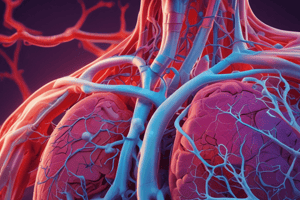Podcast
Questions and Answers
What is the average breathing rate for a healthy adult?
What is the average breathing rate for a healthy adult?
- 20 - 30 breaths per minute
- 12 - 20 breaths per minute (correct)
- 30 - 40 breaths per minute
- 5 - 10 breaths per minute
The level of oxygen in the blood is the primary mechanism that determines breathing rate.
The level of oxygen in the blood is the primary mechanism that determines breathing rate.
False (B)
What part of the brain controls the breathing rate?
What part of the brain controls the breathing rate?
medulla oblongata
Breathing is primarily controlled by the ______ in the brain.
Breathing is primarily controlled by the ______ in the brain.
Match the following factors with their effect on breathing rate:
Match the following factors with their effect on breathing rate:
Which of the following is a secondary mechanism that affects breathing rate?
Which of the following is a secondary mechanism that affects breathing rate?
Stretch receptors in the intercostal muscles send signals to the brain indicating exhalation has occurred.
Stretch receptors in the intercostal muscles send signals to the brain indicating exhalation has occurred.
What happens to the breathing rate when CO2 levels in the blood increase?
What happens to the breathing rate when CO2 levels in the blood increase?
Flashcards
Breathing Rate
Breathing Rate
The number of breaths taken per minute. A healthy adult typically takes 12-20 breaths per minute.
Brain's Role in Breathing
Brain's Role in Breathing
The medulla oblongata in the brain stem controls the breathing rate.
Breathing Mechanism
Breathing Mechanism
The brain stem sends signals to the diaphragm and intercostal muscles, causing them to contract for inhalation. Stretch receptors in the lungs send signals back to the brain, stopping inhalation. Relaxation then triggers exhalation.
CO2 Levels and Breathing
CO2 Levels and Breathing
Signup and view all the flashcards
O2 Levels and Breathing
O2 Levels and Breathing
Signup and view all the flashcards
Exercise and Breathing Rate
Exercise and Breathing Rate
Signup and view all the flashcards
Poor Ventilation and Breathing Rate
Poor Ventilation and Breathing Rate
Signup and view all the flashcards
Sickness and Breathing Rate
Sickness and Breathing Rate
Signup and view all the flashcards
Study Notes
Breathing Rate
- Breathing rate refers to how quickly or slowly a person inhales and exhales.
- A healthy adult's average breathing rate is 12-20 breaths per minute.
- Breathing rate changes to match oxygen demand or supply.
Role of the Brain
- Breathing is largely involuntary, controlled by the medulla oblongata in the brain stem.
- Higher brain centers can influence breathing, allowing for voluntary control, but this control is temporary.
- Nerve impulses from the brain stem travel down the spinal cord to muscles in the rib cage and diaphragm.
- These impulses trigger the contraction of the diaphragm and external intercostal muscles causing inhalation.
- Stretch receptors in the intercostals signal the brain about inhalation, causing the brain to stop the signal, relaxing the muscles and triggering exhalation.
What Determines Breathing Rate?
- Level of CO2 in the blood: This is the primary driver.
- Chemical receptors in the brain, carotid artery, and aorta detect CO2 levels and changes in blood pH (more CO2 leads to lower pH).
- A decrease in blood pH (higher CO2) triggers an increase in breathing rate and volume to remove CO2.
- Level of O2 in the blood: This is a secondary driver.
- Receptors in arteries monitor O2 levels in the blood.
- An extremely low O2 level triggers an increase in breathing rate. However, changes in CO2 levels are prioritized.
Factors Affecting Breathing Rate
- Strenuous activity: Increases breathing rate due to higher oxygen need.
- Poor ventilation: Increases CO2 in the air, increasing breathing rate.
- Sickness (colds, emphysema): Decreases the efficiency of breathing, increasing breathing rate.
- High altitude: Reduced oxygen levels and reduced air pressure lead to an increase in breathing rate.
Studying That Suits You
Use AI to generate personalized quizzes and flashcards to suit your learning preferences.




